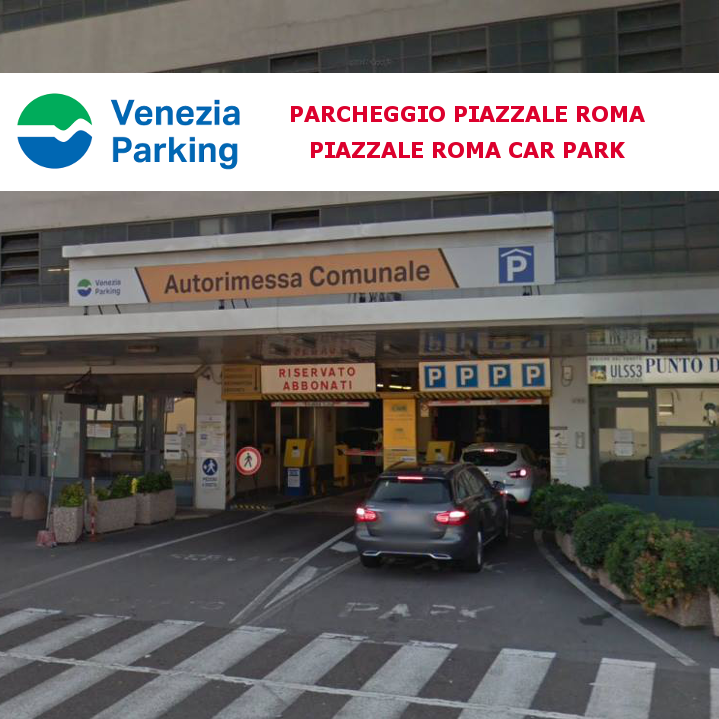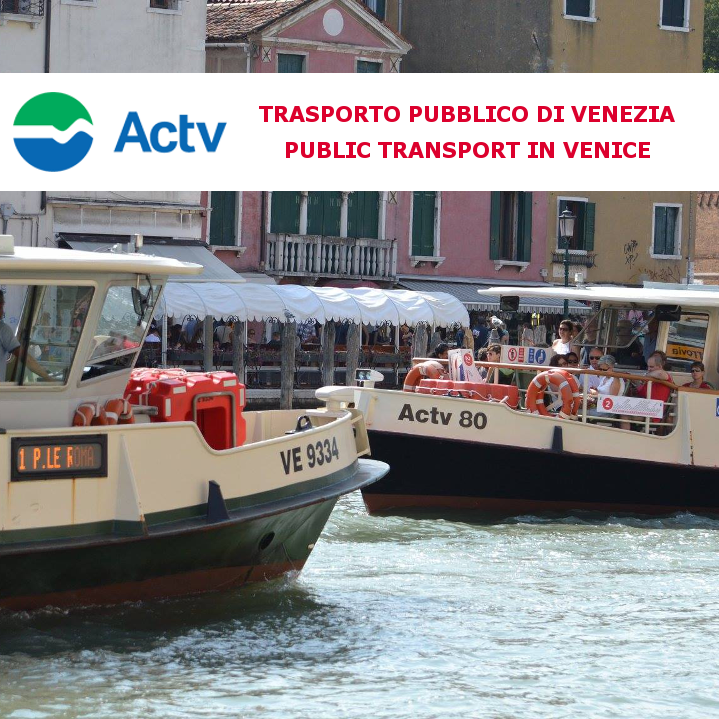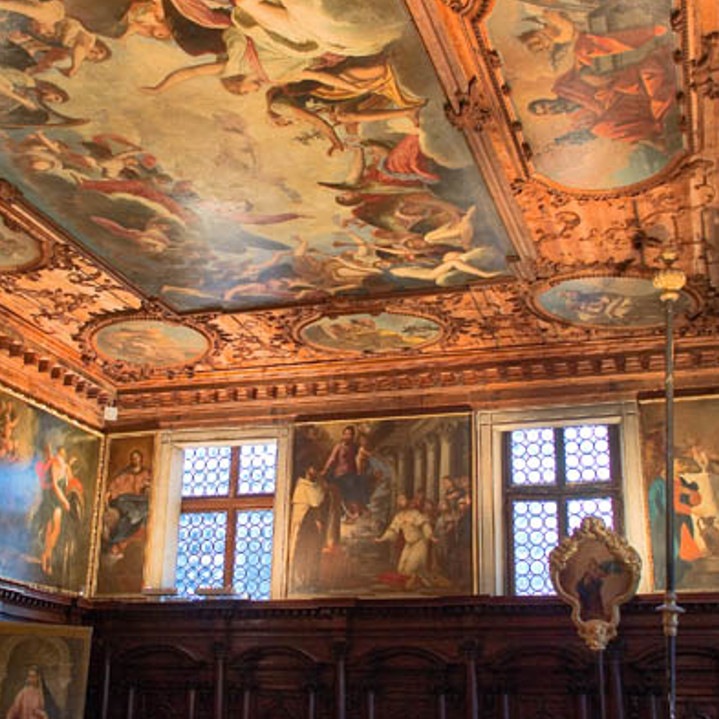You are here
Trade and power between Rialto and San Marco
Trade and power between Rialto and San Marco
This itinerary includes part of two Sestieri (districts): the walk starts in San Polo with the description of Campo di Rialto and the ancient market’s area, then after having crossed Rialto Bridge the walk goes on in San Marco, where through little streets, squares and hidden corners you will arrive to Saint Mark Square.
This walk will make you know 3 workshops that are still in San Polo: Tabinotabi, boutique of clothings and accessories on ecological and natural fabrics made according to the ancient Venetian weaving techniques while in San Marco Ca Beltà, a tailoring atelier that makes tailored clothing for men and women like in 17th tailoring workshops and Gioielleria Minotto, a jewelry workshop that presents exquisite jewels to an attentive and refined public.
The Site “Venice and its Lagoon” has been inscribed on the World Heritage List since 1987 due to its Outstanding Universal Value, therefore it belongs to all of us: it is our common duty to respect it and preserve it so that it may be passed on to future generations.
The cultural heritage of the Site goes beyond the walls of palaces, churches, beyond islands and the lagoon, but is also memory, identity, community, all fundamental elements for the its vitality.
In 2017, the City of Venice launched #EnjoyRespectVenezia campaign to raise awareness of tourists impact among visitors inviting them to maintain a respectful and polite behavior during their staying, respecting the city and its inhabitants: it is important for example to walk keeping on the right, not to stop and si on the bridges, not to feed the birds, to alway always observe a decent attitude in keeping the place you are visiting.
- Duration: about 4/5 hours including the workshops and Ducal Palace and Saint Mark Basilica
- Lenght: Approximately 3,5 km
- Mode of travel: the itinerary takes place entirely on foot
- Recommended period: all year round. In case of “acqua alta” - high tide walkways are previewed
- Accessibility: in this itinerary there are many bridges and people with reduced mobility can take vaporetto line 1 from Rialto Mercato stop to San Zaccaria in order to get Saint Mark Square: the only bridge on this way, Ponte della Paglia, is equipped of a ramp. Saint Mark Basilica has ramps to enter in and in the Doges Palace there is a lift to go up at all the floors
- Departure: Campo di Rialto
- Arrival: Piazza San Marco
- Districts: San Polo and San Marco
-
Majour attractions and highlights:
1) Rialto Bridge and market area
2) Riva del Fero and Riva del Carbon with some the most interesting palaces
3) Teatro la Fenice
4) Campo and Chiesa di Santo Stefano
5) Corte Contarini del Bovolo
6) Saint Mark Square
7) Ducal Palace
8) Saint Mark Basilica - Interconnection with other itineraries: "Medieval San Polo: merchants, courtesans and devotion"
Listen to the audio tour
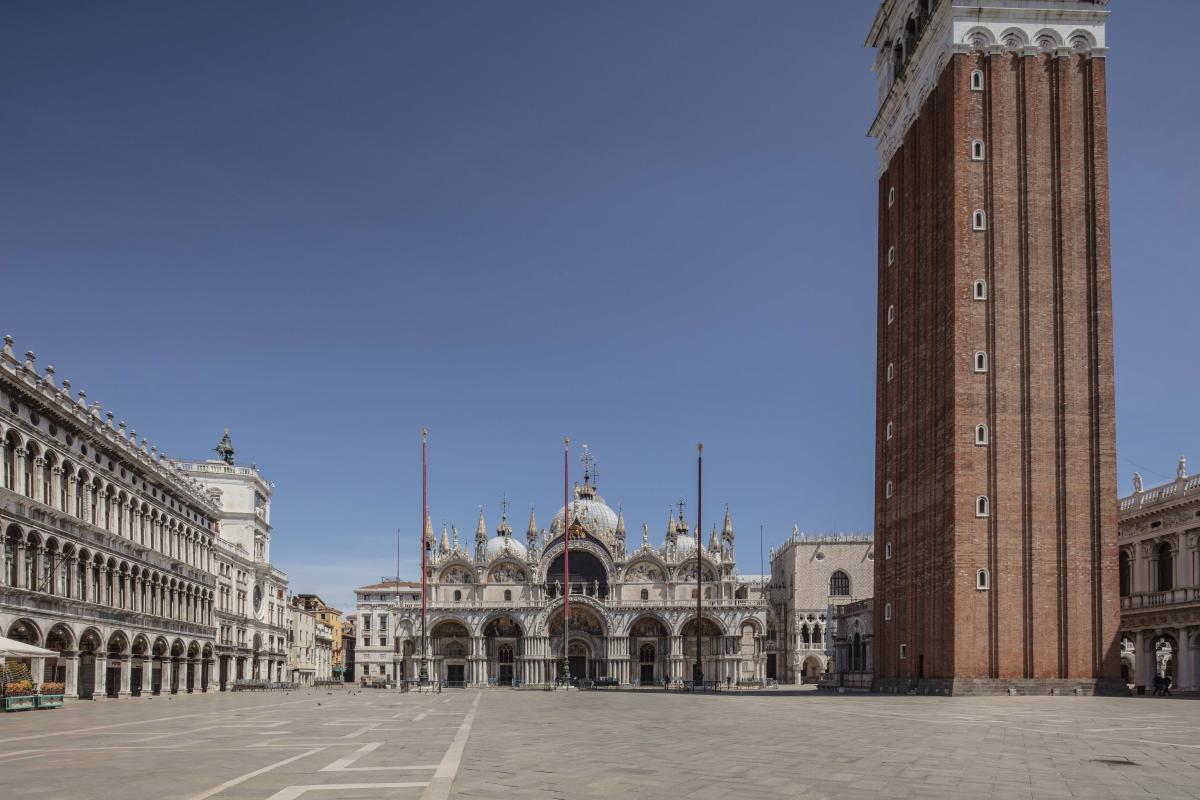
Piazza San Marco
ph. Giorgio Bombieri - Comune di Venezia
Starting point: Campo di Rialto
Starting from Campo di Rialto you have the possibility to know about the origins of Venice: according to history and tradition, the first refugees escaping from the Roman cities of the Adriatic coats, reached these islands of the lagoon on March 25 of 421 A.D.
In the Campo there is the church of San Giacomo di Rialto: the tradition says that it was first built in 421 A.D. and for that it is considered the most ancient church of Venice: it is an 11th structure and part of the original material remains still make part of the building even after the church was restored in 1531: the Gothic portico is the only remaining one of its kind in Venice.
Every year the Doge used to come to visit San Giacomo in memory of the indulgences granted by the Pope Alessandro III in 1177 and the church was reserved to the merchants.
From the Campo you can admire the Fabriche Vecchie, once seat of the State magistrates of Commerce, Administration and Navigation, built between 1520 and 1522 by Scarpagnino.
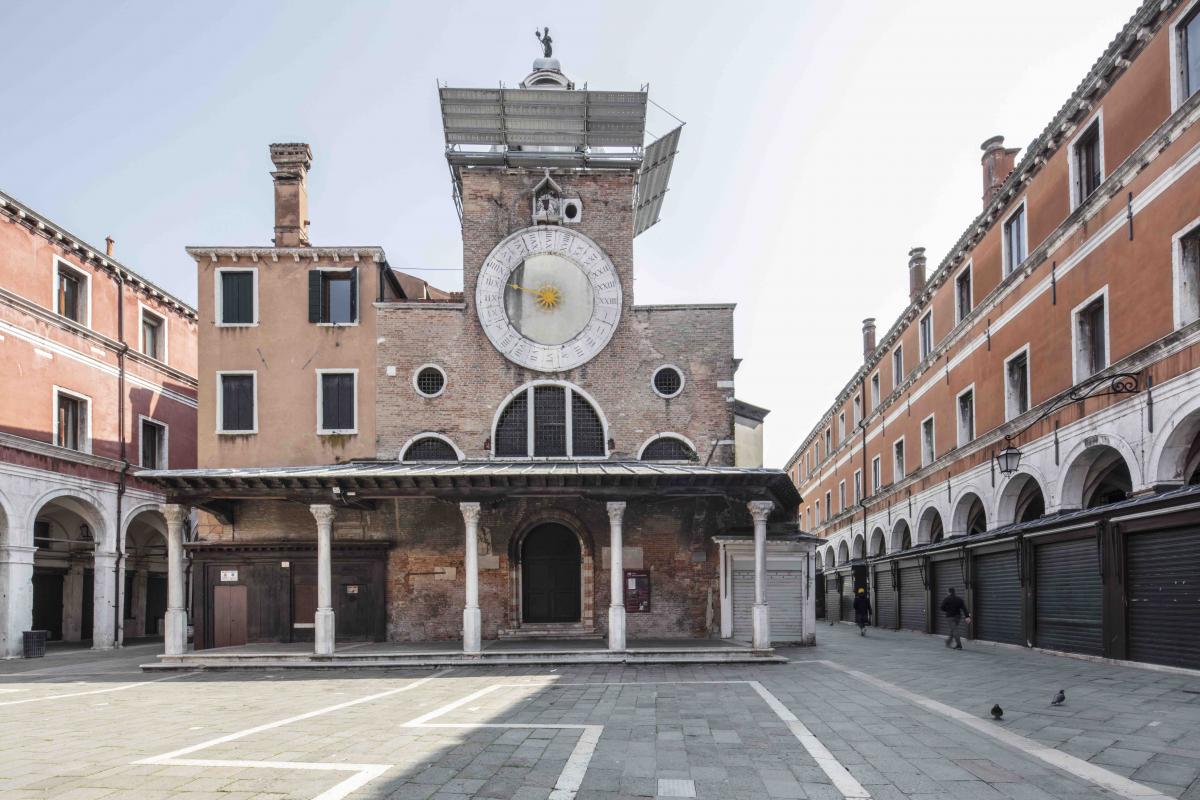
Chiesa di San Giacometo
ph. Giorgio Bombieri - Comune di Venezia
Stage 1: From Campo di Rialto to the boutique Tabinotabi (40 minutes)
You walk behind the church through Naranzaria, the place where there were conserved and sold the citrus fruits and where there is the Palazzo dei Camerlenghi - the Venetian magistrates in charge of the control of public finances - Renaissance building wanted by the Doge Andrea Gritti.
From here, after Campo Cesare Battisti (World War I Italian hero) walking along the Grand Canal, you get the Erbaria and Campo della Pescaria, the market areas where vegetables and fish were sold.
If from here you look at the Grand Canal you will see on the opposite side some extraordinary palaces as the byzantine Cà da Mosto, probably the most ancient palace on the Grand Canal (12th), Cà Sagredo - elegant ensemble of byzantine and gothic - and finally the Gothic Cà d’Oro (15th) with the splendid facade decorated with some very delicate marble freezes once entirely gilded and painted.
In this area had been shot several very well-known movies as The Tourist with Johnny Depp and Angiolina Jolie, The Merchant of Venice with Al Pacino and on the opposite side of the Grand Canal the famous scene of Casino Royal with Daniel Craig as James Bond with the palace that blew up.
Now you go back through Ruga degli Spezieri (the spices merchants) and the Ruga degli Oresi (goldsmith) to finally get Sottoportego degli Oresi to visit the boutique Tabinotabi where you will enjoy the elegant and unique clothings made on natural and ecological fabrics.
Under the arcades of the Sottoportego once there were the most fabulous jewelry shops so appreciated by the nobility and royalty of all countries.
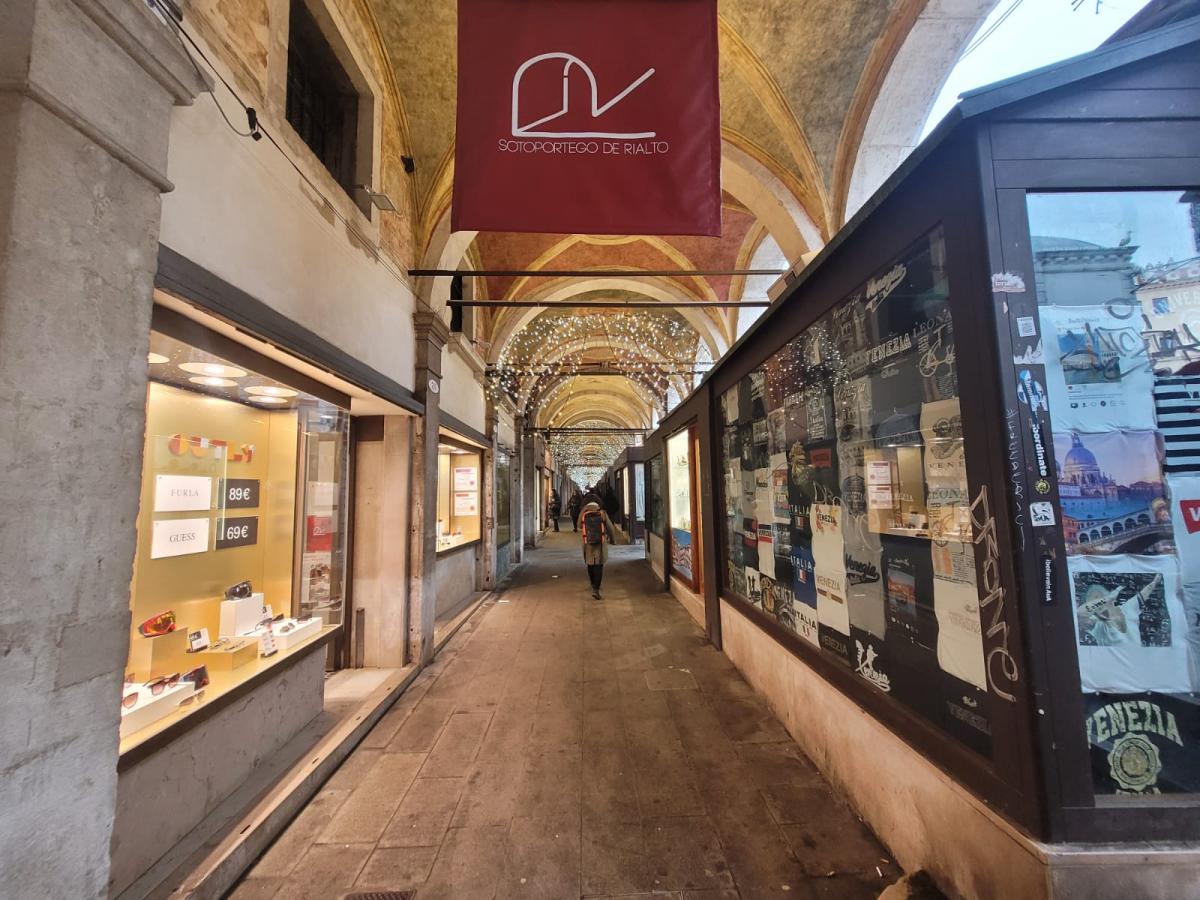
Sotoportego degli Oresi
ph. Gabriele Vattolo - Comune di Venezia
Stage 2: From Rialto Bridge to Campo Manin (25 minutes)
The name comes from the Latin “rivus altus” in order to indicate the highest part of the lagoon islands where at the beginning of the city foundation were sold the most precious and prized items protecting them from the high tides: in few years the area became the most important and fabulous market in Europe.
Rialto Bridge was built under the Doge Pasquale Cicogna by project of Antonio da Ponte between 1588 and 1592 and it definitely replaced the several wooden drawbridges there had been along the centuries: with the shops on both of its sides Rialto Bridge can be considered a kind of ancient mall.
Down the Bridge you walk on your right along the Grand Canal on Riva del Fero and Riva del Carbon where it took place the trade of metals (iron and charcoal). Here you can see some interesting palaces as Dolfin Manin, 16th by Sansovino, the gothic Palazzo Bembo and finally the Byzantine Palazzi Loredan and Farsetti, now the City Hall of Venice.
You turn around the corner of Palazzo Farsetti and walk through Campiello San Luca to arrive to Campo Manin, once San Paternian by the church demolished in the XIX century: in the middle of the Campo there is the statue of Daniele Manin, the Venetian patriot who animated the revolution against the Austrian Government in 1848 and in front of the statue, on the other side of the canal, there is the house where Daniele Manin lived.
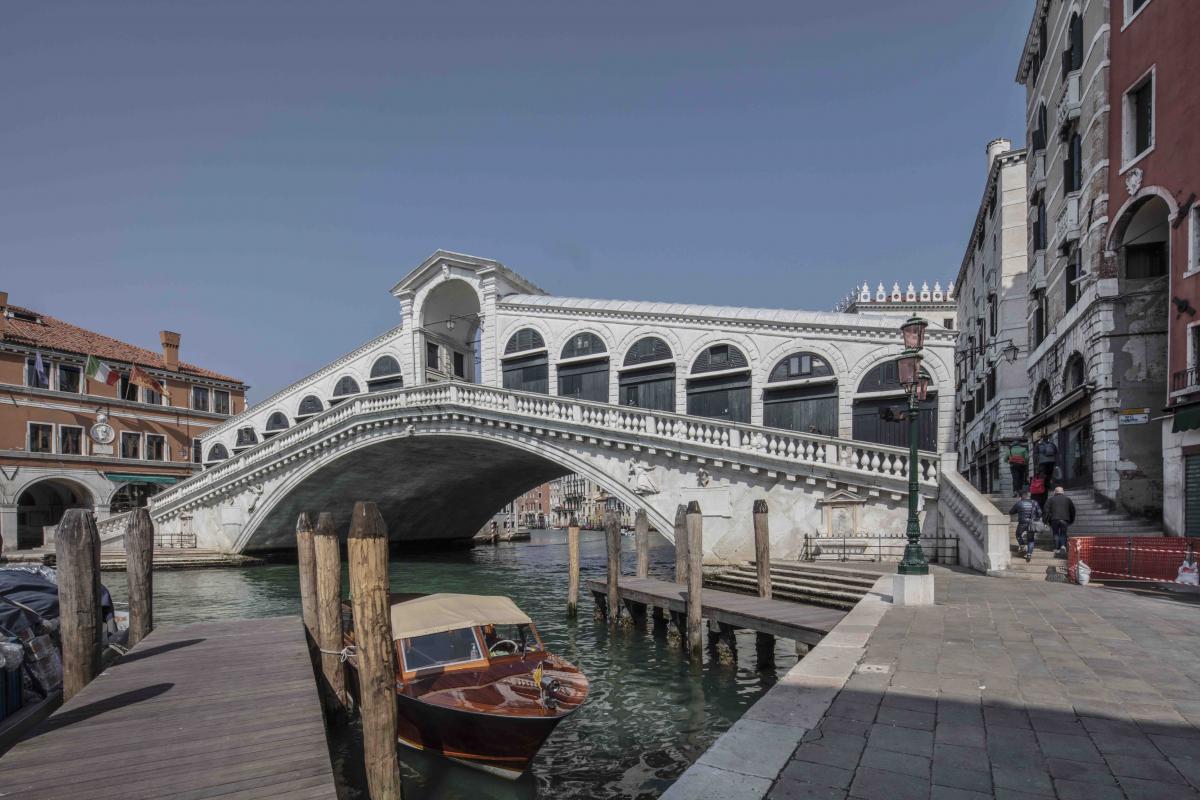
Ponte di Rialto
ph. Comune di Venezia
Stage 3: From Calle della Mandola to Campo Santo Stefano (20 minutes)
Calle della Mandola takes its name from the taprooms of bitter almond aromatic wine that once were here: the street is very alive and there are many interesting shops of elegant accessories, boutiques and dealers of antique books and engravings.
At the end of Calle della Mandola you arrive to Campo Sant’Angelo, by the name of the very ancient church - demolished in the XIXth - untitled to the Archangel Michael.
From the Campo, on the other side of the canal, you see the leaning bell tower of Santo Stefano Church and the Campo is surrounded by some palaces like for example the gothic Palazzo Duodo (house number 3584) where the composer Cimarosa died in 1801.
After the Ponte dei Frati (the Augustin friars) you arrive in front of Santo Stefano, one of the most important conventual churches of Venice, a gothic building dating form the 13th: the church has an attractive Gothic doorway and the roof is in “ship kill form” like many Venetian churches in Middle Age.
In the central nave there is the tomb of the Doge Francesco Morosini “Peloponesiaco” (the Peloponneso conqueror), hero of the Republic who was killed in a naval battle against the Turks in the Black Sea in 1694.
By the church there is the Campo which is one of the largest of Venice and where in 1802 was played the last “caccia al toro” (bullfighting) according to a very old tradition probably originally from Crete.
The Campo is surrounded by many important palaces, once residences of Venetian aristocratic families: you should especially observe the Renaissance Palazzo Loredan (n.2945) and the Baroque Palazzo Morosini (n.2802) residence of Francesco Morosini until he became Doge.
At the bottom of the Campo there is the door (n2947) of the gothic Palazzo Barbaro with facade by the Grand Canal.
Out of the Campo, to left at the far end, in between Palazzo Barbaro e Palazzo Morosini you come into Palazzo Pisani c18 (now the Music Conservatory) made built by Alvise Pisani when he came back form Versailles where he had spent several years as Venetian ambassador.
In the middle of the Campo there is the statue of Niccolò Tommaseo, patriot of Italian Risorgimento.
In this campo there some benches where it is possible to rest always remembering the rules of the campaign #EnjoyarespectVenezia for preserving the sites you are visiting.
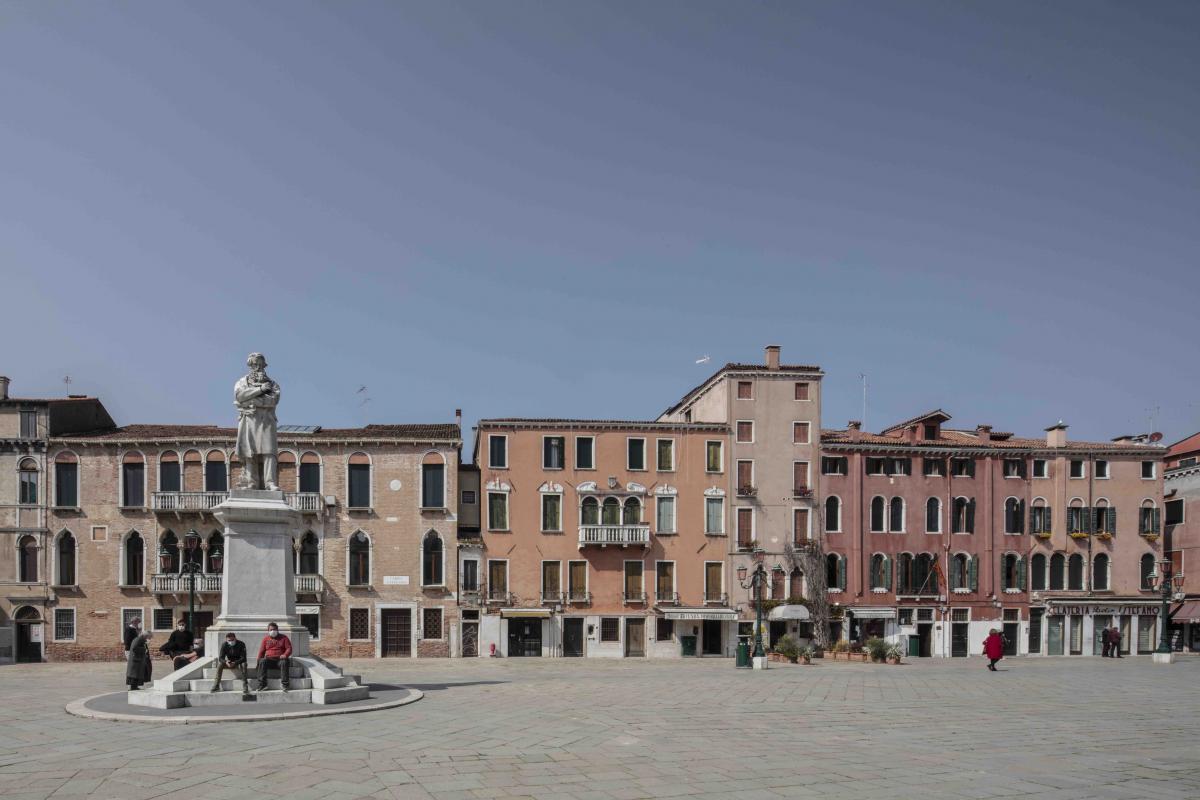
Campo Santo Stefano
ph. Giorgio Bombieri - Comune di Venezia
Stage 4: From Campo Santo Stefano to Saint Mark Square with stop at the jewelry shop Minotto and the tailoring workshop Cà Beltá (60 minutes)
You walk back to Campo Sant’Angelo and then turn on the right by Palazzo Duodo to keep Calle del Cafeter (c18 coffee shop): you arrive to Campo San Fantin from the name of the 16th church.
Here there is Teatro la Fenice, the last opera house built in Venice in 1792: the events related to its prophetic name are very well known and after the last fire in 1996 the theatre was definitely rebuilt like the one destroyed by a first fire and remade by the Austrian administration in 1836.
Leaving Campo San Fantin, you can see the late 16th Scuola di San Fantin - now seat of Ateneo Veneto- the ancient brotherhood of Santa Maria della Giustizia o Picai: the brotherhood members used to assist people condemned to death until the last moment of their life.
After Calle and Ponte del Frutarol (fruit merchant) you turn on your left and go through Calle dei Fuseri (spindles makers) and then you still turn on your left:after Calle and Corte Coppo you arrive to Corte Contarini del Bovolo from where you can admire the spiral staircase ( “bovolo” is the snail shell in Venetian language) added to the back side of the gothic Palazzo Contarini in 1495.
You go back to Calle dei Fuseri where you can visit the jewelry shop of the family Minotto, exquisite Venetian jewelers since generations.
After your pleasant stop you take Calle del Magazen (many streets in a Venice have this name that means taproom) and after few steps in Calle dei Fabbri (blacksmith) you turn to your left and finally arrive to Calle dei Monti to visit the tailoring workshop Cà Beltá.
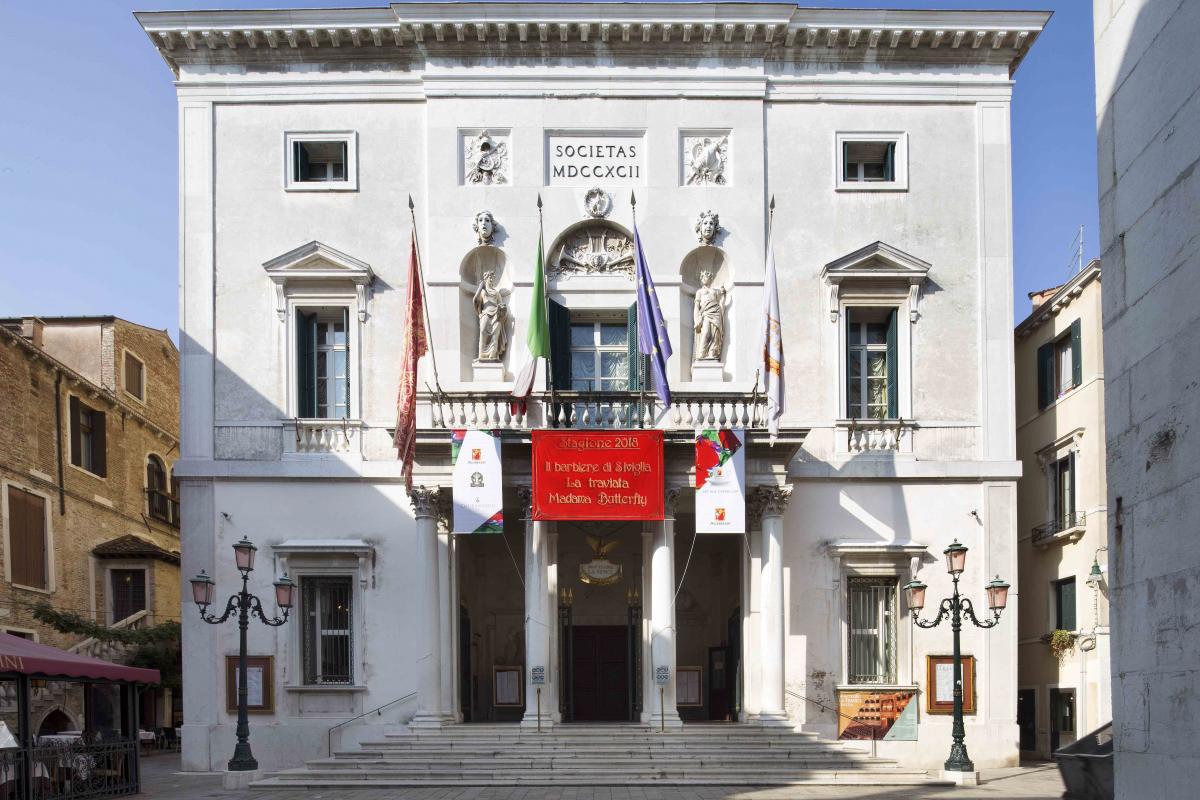
Teatro La Fenice
Stage 5: Saint Mark's Square with Doge's Palace and Saint Mark's Basilica (120 minutes)
You go now to Saint Mark Square walking through Ponte and Calle delle Ballotte (the little silk balls used for the elections of the State Councils members) and after the Ponte dei Bareteri (hatters), Merceria de San Zulian and Merceria dell’Orologio you finally arrive to Saint Mark's Square, the political and administrative center of Venice, where all buildings had been made by the State for the State: giving the back to the Basilica you see the Procuratie Vecchie (late 15th) and down the left the Procuratie Nuove (mainly 17th). These were once the homes of the Procuratori - important city officers.
Between them runs the Ala Napoleonica, the palace wanted by Napoleon, now seat of Museo Correr (same ticket of Doge's Palace).
Rising above the Procuratie Vecchie there is the Clock Tower: the two bronze mechanic figures - Mori - on the top of the tower strike the hours and during the Ascension Day the Magi emerge from the little doors on each side of the Madonna.
Between Piazza and Piazzetta you see the “campanile”, perfect reproduction of the XVI century one that fell in 1902 and rebuilt in 1912.
Saint Mark's Basilica gives its name to the Square: it is the oldest building in Venice and it was originally built in 828 to shelter the body of Saint Mark the Evangelist, brought from Egypt by two Venetian merchants.
The building you can now admire is a Byzantine one dating from the 11th under the Doge Domenico Contarini and consecrated in 1094: the Basilica was the Ducal Chapel where the Doge was blessed until the end of the Republic in 1797 and only in 1807 it became the seat of the Patriarch of Venice.
Looking at the facade of the Basilica you can see on the top of the main superior arch the gothic statue of Saint Mark blessing the city and on the balcony the copy of the copper, bronze and gold quadriga (now conserved in the Basilica Museum) taken from Constantinople in 1204 after the IV Crusade.
The entire building is decorated by precious marbles coming from all over the Oriental countries and by 8000 square-meters of extraordinary Byzantine mosaics on paste of glass and 24 ct gold representing the most important scenes of Old and New Testament.
Inside the high altar there is the sarcophagus containing the body of the Saint Evangelist and behind the altar you can admire the Pala d’oro (Golden altarpiece), marvelous masterpiece of goldsmith’s art: the 10th -12th enamels of the Pala d’Oro and the many precious stones are set in a screen which reached its present form in 1345.
The Doge's Palace rises along the Piazzetta: extraordinary example of Venetian Gothic architecture it was built between 1345 and 1436 when Venice was getting the zenith of its power over the Mediterranean: if you look at the Porta della Carta, the main door of the palace, you see a marble group representing the Doge Francesco Foscari kneeling before the lion of Saint Mark.
The route through the Palace will make you enter in the opulent rooms that housed the Venetian Government Council.
After two terrible fires that happened in 1574 and 1577 all the rooms were completely redone and decorated by the paintings of the greatest Venetian painters of Renaissance: Titan, Paolo Veronese, Jacopo Tintoretto and their disciples.
When you come out of the Palace, the Sansovino’s Library (1554) faces you across the Piazzetta: it was built to house the precious Greek ancient codes offered to Venice by the Cardinal Bessarione in the 15th.
You now walk toward the lagoon: at the end of the Piazzetta there are the two columns each carrying a statue, one of a lion symbol of Saint Mark and one of Saint Theodore - standing on a dragoon - the Greek saint protector of Venice before the body of Saint Mark was brought from Egypt in 828 and still representing the Byzantine roots of the city.
In Saint Mark's Square had been shot many scenes of very famous films like Sissi with the unforgettable Romy Schneider, Moonraker with James Bond played by Roger Moore and The young Pope where Jude Law - who plays the pope - appears from the balcony of Saint Mark's Basilica.
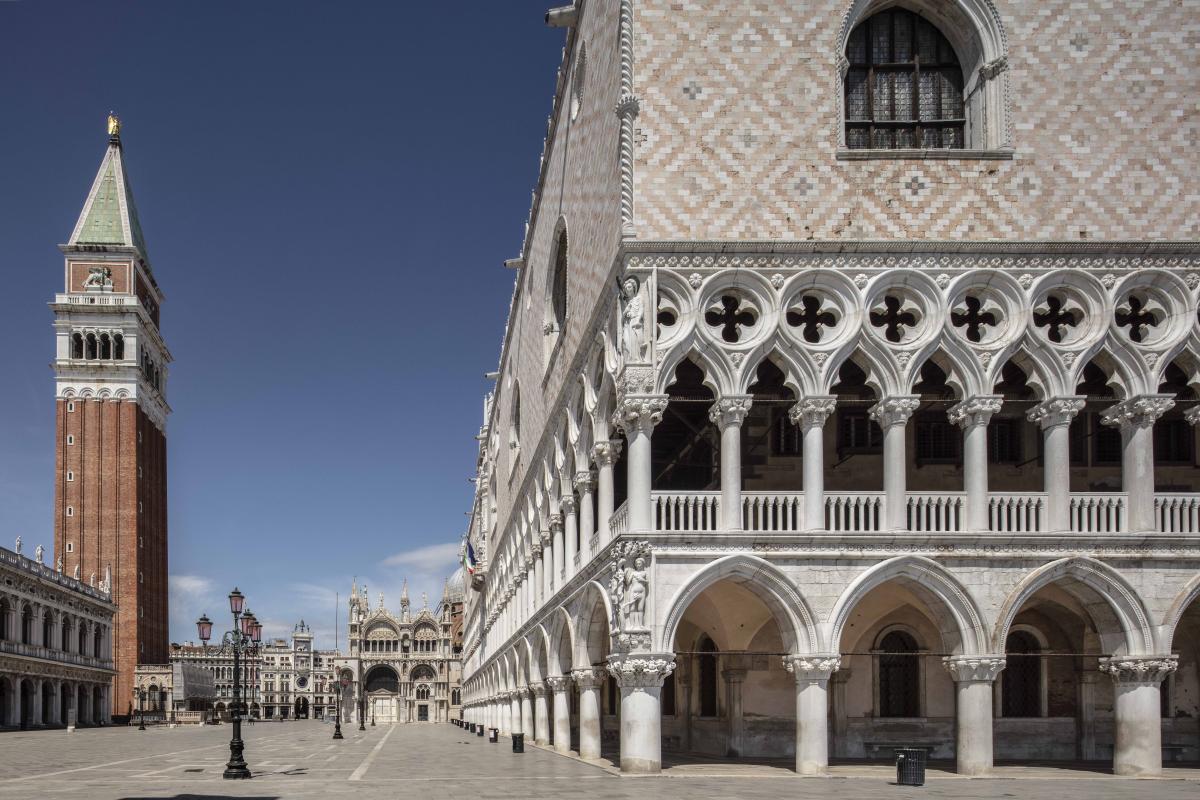
Piazzetta San Marco, Palazzo Ducale
ph. Giorgio Bombieri - Comune di Venezia
Useful information
-
Squares and rest areas: In this itinerary there are not equipped rest areas but it is possible to find several nice coffeshops in Campo Santo Stefano were you can also find some public benches.
Also under the arches of the Ducal Palace there are stone benches where you can seat and rest: it is always important to remember some of the points of the #EnjoyRespectVenezia campaign like for not to sit and stop on the bridges not to pic-nic, not to feed the birds and to observe respectful behaviors in keeping with the city and its monuments - Pay Public toilets facilities: in Campo Rialto Novo, by Campo San Bartolomeo in Calle dell’Orso and in Calle dell’Ascensione (behind Ala Napoleonica)
- Public drinking fountains: in Campo di Rialto and in Erbaria, other fountains in Saint Mark district are out of order



